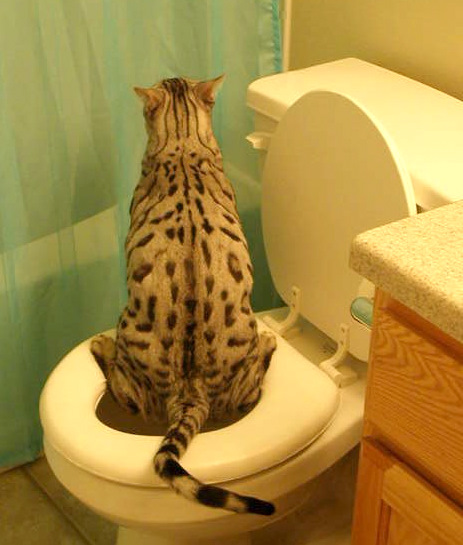Prevent Clogs and Damage: Never Flush Cat Poop Down Your Toilet - Expert Insights
Prevent Clogs and Damage: Never Flush Cat Poop Down Your Toilet - Expert Insights
Blog Article
The article author is making several great points on the subject of Can You Flush Cat Poo or Litter Down the Toilet? overall in this article on the next paragraphs.

Intro
As pet cat owners, it's essential to bear in mind exactly how we throw away our feline close friends' waste. While it may appear practical to flush feline poop down the bathroom, this technique can have detrimental repercussions for both the atmosphere and human wellness.
Environmental Impact
Purging feline poop presents harmful microorganisms and parasites into the supply of water, posing a substantial danger to aquatic environments. These impurities can adversely impact marine life and compromise water quality.
Health Risks
In addition to environmental concerns, purging pet cat waste can likewise position health threats to humans. Pet cat feces may consist of Toxoplasma gondii, a bloodsucker that can trigger toxoplasmosis-- a potentially severe health problem, particularly for expectant females and individuals with damaged body immune systems.
Alternatives to Flushing
Thankfully, there are safer and much more liable methods to dispose of cat poop. Consider the complying with alternatives:
1. Scoop and Dispose in Trash
One of the most common method of getting rid of cat poop is to scoop it into a biodegradable bag and toss it in the trash. Be sure to make use of a dedicated clutter scoop and deal with the waste without delay.
2. Use Biodegradable Litter
Choose naturally degradable feline trash made from materials such as corn or wheat. These trashes are environmentally friendly and can be safely disposed of in the garbage.
3. Hide in the Yard
If you have a backyard, take into consideration hiding pet cat waste in a marked location away from vegetable gardens and water sources. Make sure to dig deep enough to avoid contamination of groundwater.
4. Mount a Pet Waste Disposal System
Invest in a pet dog garbage disposal system especially developed for cat waste. These systems make use of enzymes to break down the waste, lowering odor and ecological effect.
Conclusion
Liable animal possession prolongs past supplying food and shelter-- it additionally involves appropriate waste monitoring. By refraining from flushing feline poop down the toilet and selecting alternative disposal methods, we can decrease our ecological footprint and shield human health and wellness.
Why Can’t I Flush Cat Poop?
It Spreads a Parasite
Cats are frequently infected with a parasite called toxoplasma gondii. The parasite causes an infection called toxoplasmosis. It is usually harmless to cats. The parasite only uses cat poop as a host for its eggs. Otherwise, the cat’s immune system usually keeps the infection at low enough levels to maintain its own health. But it does not stop the develop of eggs. These eggs are tiny and surprisingly tough. They may survive for a year before they begin to grow. But that’s the problem.
Our wastewater system is not designed to deal with toxoplasmosis eggs. Instead, most eggs will flush from your toilet into sewers and wastewater management plants. After the sewage is treated for many other harmful things in it, it is typically released into local rivers, lakes, or oceans. Here, the toxoplasmosis eggs can find new hosts, including starfish, crabs, otters, and many other wildlife. For many, this is a significant risk to their health. Toxoplasmosis can also end up infecting water sources that are important for agriculture, which means our deer, pigs, and sheep can get infected too.
Is There Risk to Humans?
There can be a risk to human life from flushing cat poop down the toilet. If you do so, the parasites from your cat’s poop can end up in shellfish, game animals, or livestock. If this meat is then served raw or undercooked, the people who eat it can get sick.
In fact, according to the CDC, 40 million people in the United States are infected with toxoplasma gondii. They get it from exposure to infected seafood, or from some kind of cat poop contamination, like drinking from a stream that is contaminated or touching anything that has come into contact with cat poop. That includes just cleaning a cat litter box.
Most people who get infected with these parasites will not develop any symptoms. However, for pregnant women or for those with compromised immune systems, the parasite can cause severe health problems.
How to Handle Cat Poop
The best way to handle cat poop is actually to clean the box more often. The eggs that the parasite sheds will not become active until one to five days after the cat poops. That means that if you clean daily, you’re much less likely to come into direct contact with infectious eggs.
That said, always dispose of cat poop in the garbage and not down the toilet. Wash your hands before and after you clean the litter box, and bring the bag of poop right outside to your garbage bins.
https://trenchlesssolutionsusa.com/why-cant-i-flush-cat-poop/

We were made aware of that article about Don’t flush cat feces down the toilet through a good friend on another web address. Liked our content? Please share it. Help other people locate it. Thanks a bunch for your time. Come back soon.
Click Here Report this page